EXPRESS SERVICE BETWEEN PASADENA AND LOS ANGELES.
The express business of the Los Angeles (Cal.) & Pasadena Electric Ry. is handled by a separate company known as the Electric Express & Storage Co., which has a 10-year contract for operating express cars over the Los Angeles-Pasadena electric line, at a stipulated sum per month, the schedule as at present agreed upon calling for four round trips for each week day and one trip on Sunday. The rate per month increases a certain amount at the end of each third year of the contract. The express cars and their motormen are furnished by the railway company, but the motormen are required to assist the express company's servants in loading and unloading goods.
Express packages are also carried on regular passenger cars between the runs of the express cars, the railway company receiving for each article so carried a stipulated amount in addition to the regular monthly rental.
When this express business was started, there were in operation between the cities of Pasadena and Los Angeles some six or eight wagons, upon which charges were very high and service poor. There are now, however, but two wagons in operation, with the prospect that they will soon have to give up, as the car service is becoming more popular every day. During the summer season, when California is very dull, the express cars are used extensively for shipping fruit, such as prunes, apricots, peaches and grapes, from the ranches on the line of the road to the canneries and wineries.
To expedite the service and for the convenience of customers in ordering, the company leases a private telephone line between the two cities, for the use of which no charge is made to regular patrons. The company also owns 15 wagons, which call for and deliver goods shipped over the electric road, no extra charge being made for delivery within a radius of one mile from company's offices in Los Angeles or Pasadena. In connection with the regular carrying business, for a nominal sum the company will take C. O. D, packages, collect for them and return the money to the consignor.
Mr. W.H. Smith, manager of the Los Angeles & Pasadena Electric Ry., in whom we are indebted for the data and accompanying illustrations, writes that in 1898 one car and two wagons were all that were required to carry on the express business, but now two cars of 20,000 lb. capacity each, 30 horses, 15 wagons are 30 men are employed. The weight of shipments at the present time average 50 tons per day. Mr. H. H. Hitt is manager of the Electric Express & Storage Co.
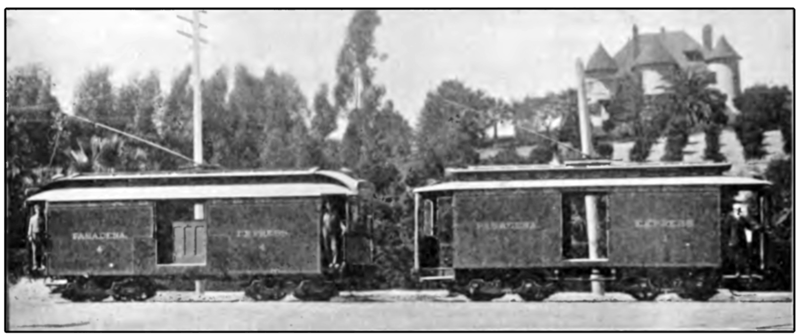
FIG. 1—EXPRESS CARS—LOS ANGELES & PASADENA RY.
In Fig. 1 are shown the two special express cars. No. 4 is equipped with two 50-h.p. Westinghouse motors, and No. 1 with two 40-h.p. motors of the same make.
Figs. 2 to 7 are reproductions of blanks used in carrying on the business.
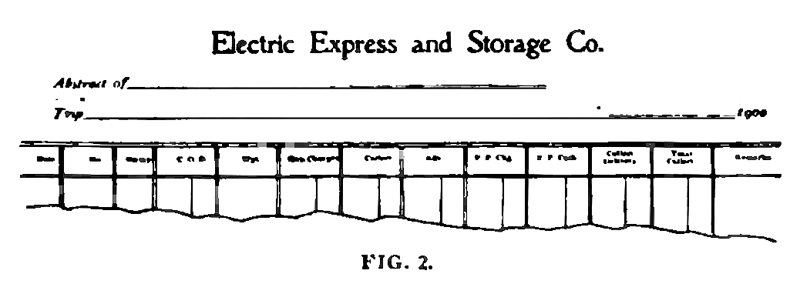
FIG. 2
Fig. 2 is the form made up by clerks at the initial office, showing abstract of each car load of express matter. From this blank the bookkeeper makes proper distribution of charges. The original is 13¾ x 8½ in.
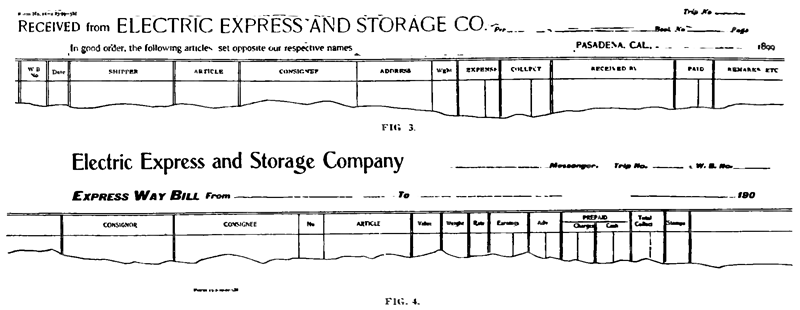
FIG. 3
Fig. 3 is a form made up by clerks at the sending office, checked by the express messenger, and by him turned over to the checking clerk at the destination office, again checked and delivered to the driver of the delivery wagon, by whom the delivery is made and who secures the signature of the consignee in acknowledgment of the receipt. The original is 14¼x8 in.
Fig. 4 is the regular way bill, made up in part by the shipping clerk and by the express messenger, by whom it is turned over to the receiving clerk at the destination and properly entered on the form shown in Fig. 2 The original is 14x4¼in.
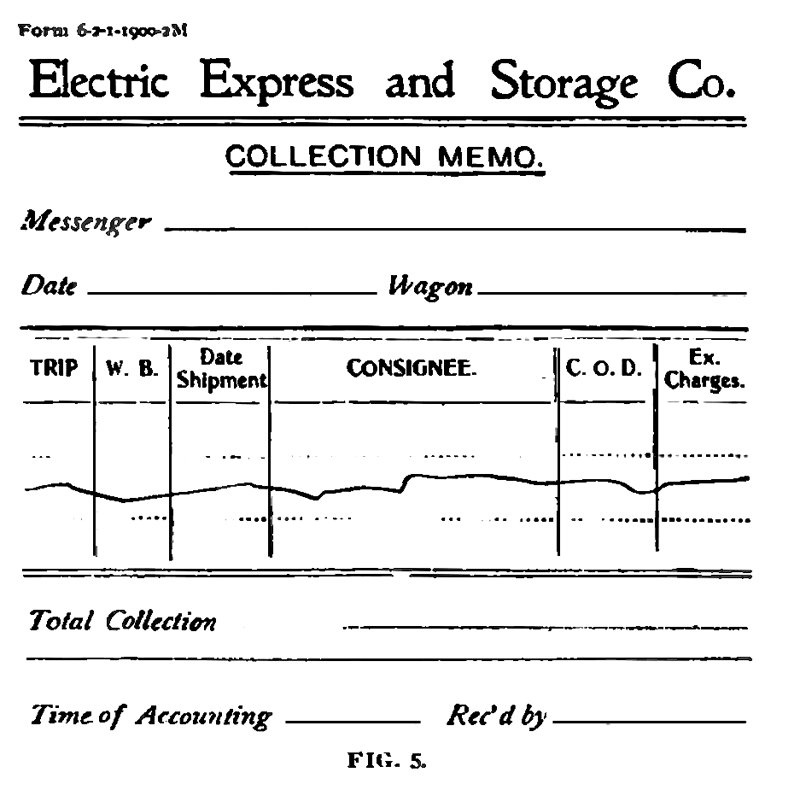
FIG. 5
The collection memorandum (Fig. 5) is made up by the driver of the collecting wagon, and by him delivered to the receiving clerk; it is then checked, receipted for and returned to the driver for his record. The shipping clerk is furnished with a copy of this form, and entry is made by him on the way bill (Fig. 4).
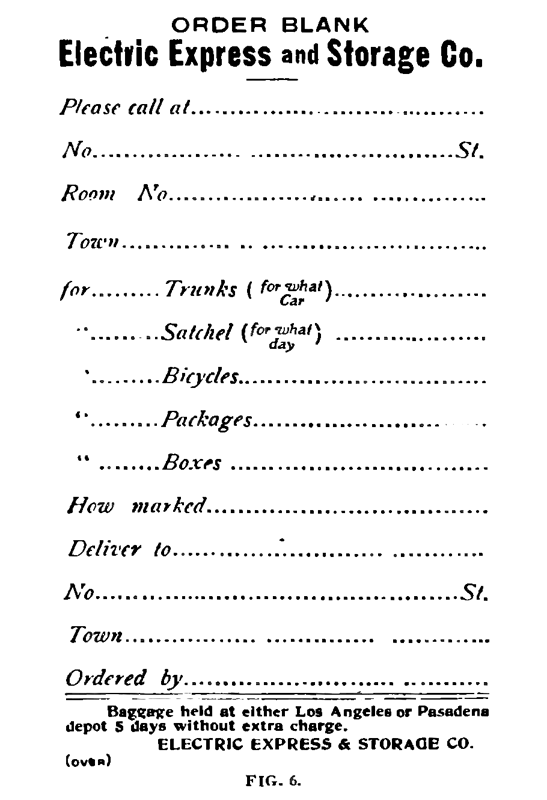
FIG. 6
Fig. 6 is a small order blank furnished for the convenience of patrons. The blank itself is 2¾x4½in. and forms one page of a four-page folder, the other three pages of which are devoted to advertising the service and to a schedule card showing the leaving time of the express cars.
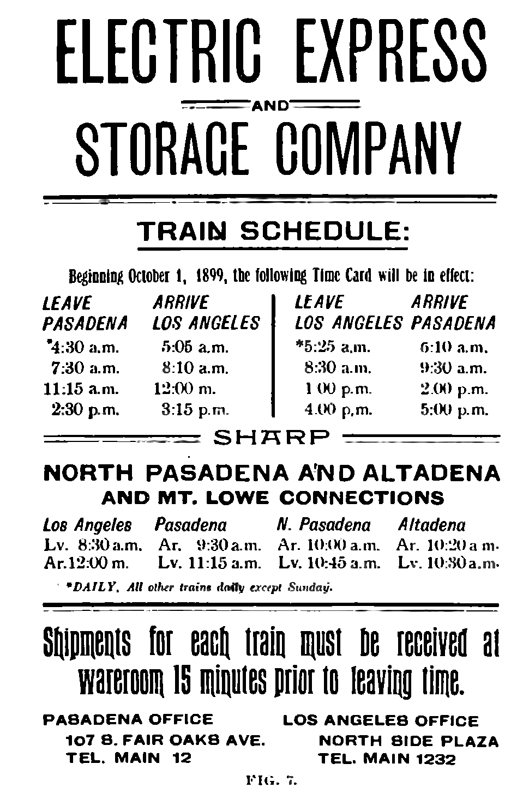
FIG. 7
Fig. 7 is a notice which is used in various sizes for advertising purposes. It is printed on the back of order blanks, in hand bill form, and in poster form.
The C. O. D. feature has grown to large proportions, and is taken advantage of by merchants and dealers all along the line, who can in this way fill mail and telephone orders as quickly and as safely as they could with their own wagons. When the express company collects a bill for a package delivered, it retains the money and remits the amount to the sender by its own check, taking a receipt therefor. The bill accompanying articles which are to be paid for on delivery is placed in a heavy manila envelope, 3x5½in., on the outside of which are blank spaces for filling in amount of bill and charges for returning money, names of consignor and consignee, and way bill number.

The Street Railway Review pgs. 729-731 Vol. X, No. 12., 1900-12-15
Return to ERHA homepage
